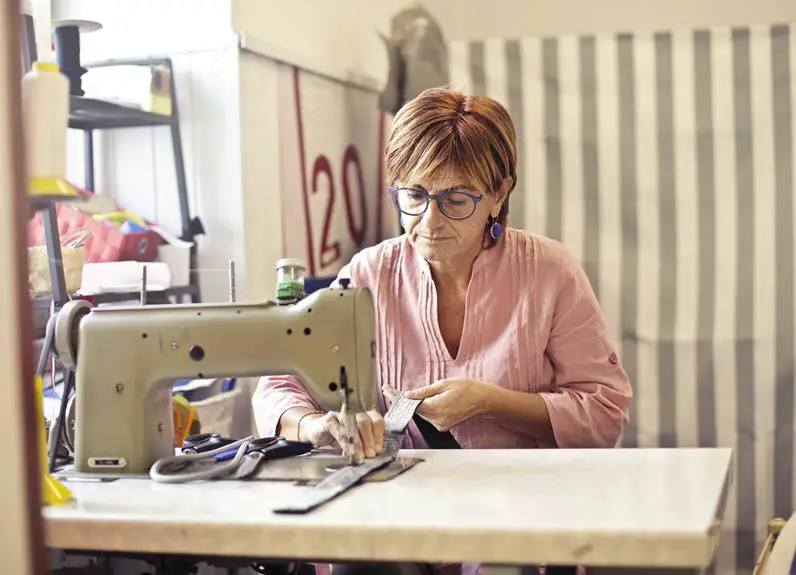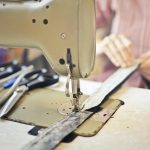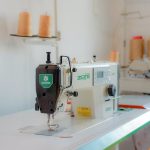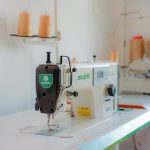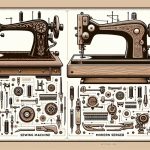Looking to tackle upholstery projects like a pro? You might not know that choosing the right sewing machine is crucial for achieving flawless results. With the array of options available, finding the best one may seem daunting. Fear not! This guide will equip you with the knowledge to make an informed decision.
From heavy-duty construction to specialized features, you'll uncover the key factors to consider. Get ready to elevate your upholstery game as we delve into the top models, expert tips for selection, and essential maintenance advice.
Let's dive into the world of upholstery sewing machines and master this craft with confidence.
Key Takeaways
- A strong motor and heavy-duty construction are important features to consider when choosing a sewing machine for upholstery.
- Look for a sewing machine that offers a variety of stitch options to accommodate different upholstery projects.
- Ensure that the sewing machine has a suitable needle size for heavy fabrics to ensure optimal stitching results.
- Consider the durability and robust build of the sewing machine to ensure it can handle the demands of upholstery projects.
Key Features to Consider
When choosing a sewing machine for upholstery, you should look for a machine with a strong motor and heavy-duty construction to handle thick fabrics and multiple layers. Durability is key when dealing with upholstery projects. The machine should offer a variety of stitch options to accommodate different sewing techniques required for upholstery work. Additionally, consider the needle size suitable for heavy fabrics and the ability to adjust the presser foot height to accommodate the thickness of the materials.
To ensure the machine can handle the demands of upholstery, opt for a model with a robust and durable build. Look for machines specifically designed for heavy-duty sewing tasks, as they're more likely to withstand the rigors of upholstery projects. The ability to adjust the presser foot height is crucial when working with thick upholstery fabrics, as it allows for smooth and even stitching.
Prioritize a sewing machine that offers a range of stitch options, a strong and durable build, and the flexibility to adjust needle size and presser foot height to master upholstery projects effectively.
Comparison of Top Models
Consider the top three sewing machines for upholstery, each offering unique features and capabilities to meet various upholstery needs. When comparing these top models, it's essential to examine key factors such as stitch options, durability, speed control, and needle position. Here's a comparison table to help you evaluate the top models:
| Feature | Model A | Model B | Model C |
|---|---|---|---|
| Stitch Options | Over 100 | 75 | 150 |
| Durability | Heavy-duty metal | Reinforced plastic | Steel frame |
| Speed Control | Adjustable | 1,100 stitches/min | Variable speeds |
| Needle Position | Multiple positions | Center/Left | Center |
Each of these sewing machines offers unique advantages. Model A provides a wide range of stitch options, ensuring versatility in upholstery projects. Model B, with its high speed and durable construction, is suitable for heavy-duty upholstery work. Model C stands out with its durable steel frame and variable speed control, offering precise needle positioning for various upholstery tasks. Consider these factors carefully when choosing the best sewing machine for your upholstery needs.
Expert Tips for Choosing
To make an informed decision, start by researching different sewing machines for upholstery at least a month before you plan to purchase one.
Here are some expert tips to consider:
- Brand recommendations: Look for well-established brands known for producing high-quality sewing machines suitable for upholstery work. Brands like Janome, Juki, Singer, and Brother are often recommended by experts for their durability and performance.
- Stitch type options: Ensure the sewing machine offers a variety of stitch types suitable for upholstery work. Look for machines with straight stitches, zigzag stitches, and even decorative stitches to cater to different upholstery projects.
- Heavy-duty build: Opt for sewing machines specifically designed for heavy-duty projects. These machines are equipped with stronger motors and sturdier frames to handle thick upholstery fabrics and multiple layers with ease.
- Walking foot attachment: Consider a sewing machine that comes with a walking foot attachment. This feature helps to feed multiple layers of fabric evenly, preventing shifting and puckering, which is essential for upholstery work.
Maintenance and Care Tips
As you maintain your sewing machine for upholstery, ensure that you regularly clean and oil it to keep it in optimal working condition. Cleaning the machine after each use prevents the buildup of lint and dust, which can affect its performance. Use a small brush to remove debris from the feed dogs, bobbin case, and tension discs. Additionally, oiling the machine at the designated points reduces friction and wear, extending its lifespan.
When working with upholstery fabric, it's crucial to select the appropriate needle for the specific material. For heavier fabrics like canvas or denim, a sturdy needle, such as a size 16 or 18, is recommended to ensure smooth stitching without breakage. On the other hand, for lighter upholstery fabrics like silk or satin, a finer needle in the range of 9 to 11 will prevent unnecessary damage to the delicate fabric.
Consider the following maintenance and care tips for your sewing machine:
| Maintenance Tips | Care Tips |
|---|---|
| Regular cleaning | Proper storage |
| Oiling | Thread tension check |
| Needle selection | Belt and motor inspection |
| Lubrication | Timing adjustment |
Upholstery Sewing Machine Accessories
When sewing upholstery, you'll need to invest in accessories for your machine that meet the demands of heavy-duty fabrics and intricate stitching.
To ensure your sewing machine is equipped for upholstery projects, consider these essential accessories:
- Heavy-duty Needles: Upholstery projects require strong needles that can penetrate through thick layers of fabric and batting. Look for needles labeled specifically for heavy fabrics.
- Walking Foot: This attachment helps to feed multiple layers of fabric evenly through the machine, preventing shifting and puckering. It's essential for maintaining even stitch length and preventing fabric slippage.
- Topstitching Thread: When working with upholstery fabric, topstitching adds durability and a professional finish. Invest in high-quality, heavy-duty topstitching thread that complements your fabric.
- Adjustable Zipper Foot: For upholstery projects that involve adding zippers, an adjustable zipper foot is crucial. It allows you to stitch close to the zipper coils and bulky seam allowances with ease, ensuring a neat and secure finish.
When selecting accessories, pay attention to stitch length and needle size compatibility to ensure your machine is optimized for upholstery work.
Frequently Asked Questions
Can I Use a Regular Sewing Machine for Upholstery Projects?
Yes, you can use a regular sewing machine for upholstery projects, but a heavy-duty sewing machine is better suited for the task. It provides the necessary power and durability for upholstery sewing techniques.
What Type of Needle and Thread Should I Use for Upholstery Sewing?
When sewing upholstery, choose heavy-duty needles and strong thread to handle the fabric's thickness. Keep your sewing machine well-maintained for smooth operation. For beginners, practice on scrap fabric to perfect your technique before tackling larger projects.
How Do I Determine the Right Sewing Machine Size and Power for My Upholstery Projects?
To determine the right sewing machine size and power for your upholstery projects, consider the thickness of materials you'll be sewing and the type of projects you'll be working on. Choosing the appropriate materials and supplies is crucial.
Are There Any Specific Techniques or Stitches I Should Use for Upholstery Sewing?
When sewing upholstery, use heavy-duty stitches like a straight stitch or a zigzag stitch for added durability. Consider using a walking foot attachment to prevent shifting. Experiment with different sewing machine techniques to find what works best for your project.
What Are Some Common Mistakes to Avoid When Using a Sewing Machine for Upholstery?
When using a sewing machine for upholstery, common mistakes include using the wrong needle size, not adjusting tension properly, and neglecting to use appropriate thread. Troubleshooting tips involve checking needle and thread compatibility and adjusting tension as needed.
- How Does Ring Spun Cotton Affect Garment Fit and Shape Retention? - August 13, 2024
- What Are the Challenges in Producing Ring Spun Cotton? - August 13, 2024
- Is Ring Spun Cotton Suitable for Plus-Size Clothing? - August 13, 2024

